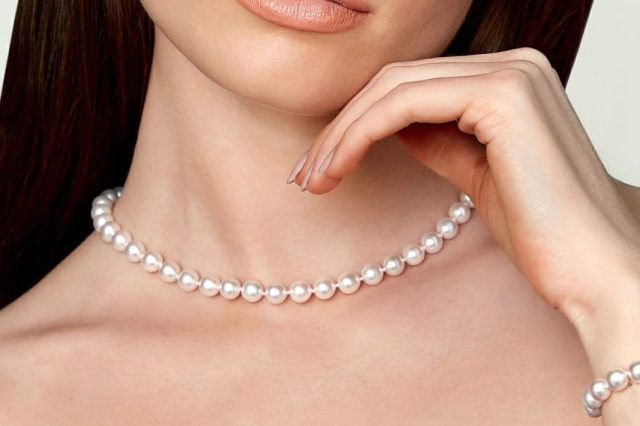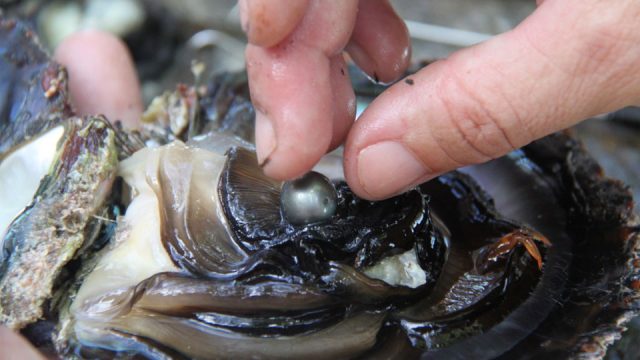When you think of a classic white pearl—perfectly round, radiant, and glowing with elegance—it likely came from an Akoya oyster. These small saltwater oysters are the source of one of the world’s most prized pearl types: the Akoya pearl.
Native to Japan and celebrated for their ability to produce pearls with unmatched luster, Akoya oysters have played a vital role in the pearl industry for more than a century. In this guide, we’ll explore where they’re found, how they produce pearls, and why they remain so important in fine jewelry.

Akoya oysters (Pinctada fucata martensii) are small saltwater oysters native to the coastal waters of Japan. These mollusks are known for producing consistently round, highly lustrous pearls—often in shades of white or cream with silver, rose, or ivory overtones.
Each oyster typically produces just one pearl per cycle, and due to low survival rates and strict cultivation standards, Akoya pearls are extremely rare compared to freshwater varieties. This rarity, combined with their visual appeal, makes Akoya pearls some of the most desirable in the world.
At The Pearl Source, many of our signature pieces feature Akoya pearls sourced directly from these oysters—known for their elegance, uniformity, and brilliance.

Akoya oysters thrive in clean, temperate waters. Today, they are farmed primarily in:
Japan remains the most respected source, thanks to its long history of pearl cultivation and meticulous farming practices. However, China now produces a large share of the global Akoya pearl supply, and Vietnam also contributes as a growing producer.
The cultivation of Akoya pearls is a detailed, time-sensitive process that blends tradition with modern technique:
Only a portion of oysters yield gem-quality pearls. Most are retired after harvest, making each Akoya pearl the result of months of precise care.
Akoya pearls are celebrated for their exceptional qualities, making them a favorite among pearl enthusiasts and jewelers alike. Here are some of the standout characteristics that set Akoya pearls apart:
The modern cultured pearl industry began with the Akoya oyster. In 1893, Kokichi Mikimoto, a Japanese entrepreneur and innovator, successfully created the first cultured Akoya pearl—ushering in a new era for pearls worldwide.
Mikimoto’s work revolutionized jewelry and elevated the Akoya oyster to global recognition. Today, many Japanese pearl farms continue to operate in the same regions Mikimoto helped develop, blending traditional methods with environmentally responsible practices.
Akoya oysters are among the smallest pearl-producing oysters, growing to just 6–8 cm across. Because of their delicate nature, they require pristine water conditions and daily monitoring.
Farmers regularly clean the oysters, rotate them through carefully selected sea areas, and monitor water quality to ensure ideal nacre development. Once pearls are harvested, most oysters are not reused, making sustainability and ethical practices a priority for modern farms.

Not all oysters are created equal—and not all produce the same type of pearl. Here’s how Akoya oysters compare to other major pearl-producing species:
| Oyster Type | Primary Regions | Pearl Type | Typical Pearl Size | Notable Features |
|---|---|---|---|---|
| Pinctada fucata (Akoya) | Japan, Vietnam, China | Akoya Pearls | 6–9mm | High luster, classic round shape |
| Pinctada maxima (South Sea) | Australia, Philippines | South Sea Pearls | 9–16mm | Larger size, softer glow |
| Pinctada margaritifera (Tahitian) | French Polynesia | Tahitian Pearls | 8–14mm | Naturally dark colors, metallic overtones |
| Freshwater mussels | China | Freshwater Pearls | 5–12mm | Variety of shapes/colors, often less round |
Akoya oysters, a type of pearl producing oyster, produce some of the smallest but most refined pearls, which is why they’re often used in delicate necklaces, earrings, and bridal jewelry. While the average Akoya pearl measures around 7mm, the average South Sea pearl is significantly larger at around 12mm. Akoya pearls are generally rounder and have a higher value than traditional freshwater pearls, which are produced in different regions and ways.
Akoya pearls are considered a valuable commercially produced pearl, though they rank behind White and Golden South Sea pearls and Tahitian South Sea pearls in terms of commercial value.
From oyster to jewelry box, Akoya pearls undergo a series of careful steps to ensure they meet strict quality standards:
This process ensures that the pearls you receive are as beautiful and durable as nature allows.
When most people picture a “perfect pearl,” they’re usually imagining an Akoya pearl—bright, round, white, and glowing with elegance. Akoya pearl oysters are known for their precision and rarity, contributing to the high value and desirability of the pearls they produce.
Akoya oysters were the first mollusks used in successful pearl cultivation and remain central to the industry today. Their pearls are favored for:
Their pearls are favored for:
Are Akoya oysters freshwater or saltwater?
Saltwater—they thrive in coastal environments in Japan, China, and Vietnam.
How long does it take to grow an Akoya pearl?
Usually between 10 and 18 months.
Do Akoya oysters produce more than one pearl?
No. Most are nucleated once and produce a single pearl per cycle.
Are Akoya pearls always white?
Most are white or cream with silver, rose, or ivory overtones. Rare blue tones also exist.
Do Akoya oysters survive after pearl harvest?
Some do, but most are not reused after harvest.
How big do Akoya oysters grow?
Around 6–8 cm (2.5–3 inches), making them the smallest commercially farmed oyster species.
What do Akoya oysters eat?
They’re filter feeders, consuming plankton and microscopic algae.
At The Pearl Source, we’re proud to work with some of the finest Akoya pearl farms in the world—many located in the same coastal waters where cultured pearls were first developed over a century ago. We select only the highest-quality Akoya pearls, known for their unmatched luster, symmetry, and timeless appeal.
Every Akoya pearl we offer is a result of expert farming, meticulous grading, and a commitment to craftsmanship that reflects our dedication to quality. Whether you’re purchasing your first strand or adding to a growing collection, you can trust that your pearls have been responsibly sourced and carefully curated.
Signup now and receive an email once I publish new content.

Content Writer and Editor at The PearlSource
Kate Muirhead is the editor and content writer for leading pearl retailer The Pearl Source. She believes in the power of signature jewelry, and that collecting it is half the fun.